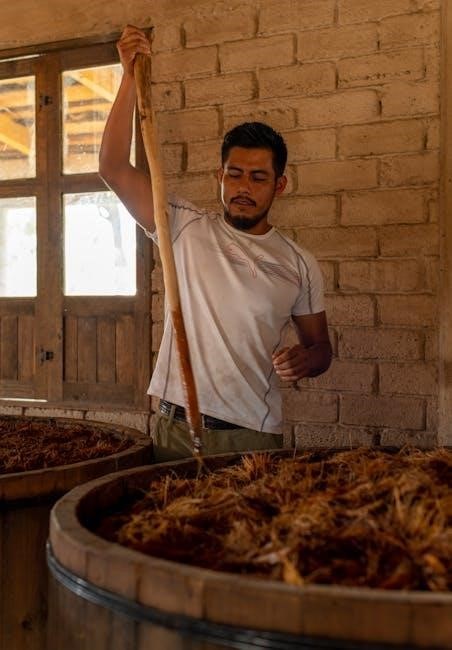
Bifen I/T is a professional-strength liquid concentrate insecticide containing 7.9% bifenthrin, effective against over 75 pests, including termites, mosquitoes, and cockroaches. Ideal for indoor and outdoor use.
Overview of Bifen I/T Insecticide
Bifen I/T is a professional-grade insecticide formulated as a liquid concentrate, containing 7.9% bifenthrin, a synthetic pyrethroid. It is widely used for controlling over 75 pest species, including termites, mosquitoes, carpenter ants, and cockroaches. Known for its broad-spectrum efficacy, Bifen I/T provides long-lasting residual control, often persisting for up to 3 months. It is odorless, non-staining, and dries clear, making it suitable for both indoor and outdoor applications. The product is versatile, allowing use in residential, commercial, and agricultural settings. Bifen I/T is particularly popular among pest control professionals due to its reliability and effectiveness. Proper mixing with water is essential to achieve optimal results, ensuring the solution is applied correctly for targeted pest control.

Key Features and Benefits
Bifen I/T stands out for its high concentration of 7.9% bifenthrin, a potent synthetic pyrethroid, ensuring strong insecticidal activity. It offers long-lasting residual control, lasting up to 3 months, reducing the need for frequent reapplications. The formula is odorless and non-staining, making it ideal for indoor use without leaving residues. Its broad-spectrum efficacy targets over 75 pests, including resistant species. Bifen I/T is versatile, suitable for both indoor and outdoor applications, including lawns, gardens, and structural perimeters. It is also safe for use around children and pets when applied as directed. The product’s professional-strength formula ensures reliable results, making it a preferred choice for pest control professionals and homeowners alike. Its effectiveness and convenience make it a top option for managing a wide range of insect infestations.
Common Uses of Bifen I/T
Bifen I/T is widely used for controlling a broad range of insect pests, including termites, mosquitoes, cockroaches, earwigs, and ants. It is commonly applied in residential and commercial settings for both indoor and outdoor pest management. The insecticide is effective for treating lawns, gardens, foundation perimeters, and structural areas to prevent infestations. It is also used to control pests in mulch beds, decks, and fence lines. Bifen I/T is particularly popular for its ability to provide long-lasting residual control, making it a reliable choice for seasonal pest prevention. Its versatility and broad-spectrum efficacy make it a go-to solution for professionals and homeowners addressing various pest-related issues.

Active Ingredients and Concentrations
Bifen I/T contains 7.9% bifenthrin, a synthetic pyrethroid insecticide, providing long-lasting control of over 75 pests, including termites, mosquitoes, and cockroaches, with residual effects up to 3 months.
What is Bifenthrin?
Bifenthrin is a synthetic pyrethroid insecticide, a man-made version of natural insecticides derived from pyrethrins found in chrysanthemum flowers. It works by disrupting the insect’s nervous system, causing paralysis and eventual death. Bifenthrin is widely used in agricultural, residential, and public health settings due to its effectiveness against a broad spectrum of pests, including mosquitoes, ticks, termites, and other insects. It is known for its rapid knockdown effect and long-lasting residual activity, often providing control for up to 3 months. Bifenthrin is also odorless and non-staining, making it a popular choice for indoor and outdoor applications when used as directed. Its safety profile for humans and pets when properly applied further enhances its versatility in pest control scenarios.

Concentration of Bifenthrin in Bifen I/T
Bifen I/T contains 7.9% bifenthrin as its active ingredient, making it a highly concentrated formula for effective pest control. This concentration is significantly higher than other formulations like Bifen LP, which contains only 0.2% bifenthrin. The 7.9% concentration in Bifen I/T ensures strong residual activity and long-lasting control against a wide range of pests, including termites, mosquitoes, and cockroaches. It is formulated as a flowable liquid concentrate, designed to be mixed with water for application. The high concentration allows for precise mixing ratios, ensuring optimal performance while maintaining safety when used as directed. This formulation makes Bifen I/T a versatile and powerful tool for both indoor and outdoor pest management scenarios.
How Bifenthrin Works
Bifenthrin, the active ingredient in Bifen I/T, is a synthetic pyrethroid that disrupts the nervous system of insects. It works by altering the normal function of voltage-gated sodium channels in insect nerve cells, leading to hyperexcitation, paralysis, and eventual death. This mode of action is effective against a wide range of pests, including insects resistant to other pyrethroids. Upon contact or ingestion, bifenthrin rapidly affects the insect’s nervous system, causing immediate immobilization. Its residual activity provides long-lasting protection, ensuring continued control of pests for an extended period after application. This dual action makes bifenthrin a reliable and efficient component in pest management strategies, offering both quick knockdown and sustained control.

Mixing Instructions for Bifen I/T
Bifen I/T is mixed by adding the recommended amount to a gallon of water, typically 1 ounce per gallon, ensuring proper dilution for effective pest control.
General Mixing Guidelines
Bifen I/T is a liquid concentrate that must be mixed with water according to the label instructions for optimal effectiveness. Always use clean, cool water to ensure proper mixing and avoid contamination. Measure the product accurately using a calibrated measuring device to achieve the correct concentration. Mix thoroughly by agitating the solution to ensure the product is fully incorporated. Avoid mixing more solution than needed, as unused portions may not remain stable. Store mixed solutions in a clearly labeled, sealed container and use within a few days of preparation. Wear personal protective equipment (PPE) during mixing to minimize exposure. Never mix Bifen I/T with other pesticides or chemicals unless specified on the label. Proper mixing ensures safety and efficacy in pest control applications.
Recommended Mix Ratio
The recommended mix ratio for Bifen I/T varies depending on the target pest and application site. For general pest control, mix 1 ounce of Bifen I/T with 1 gallon of water. For heavier infestations or longer residual control, the ratio can be increased to 2 ounces per gallon. When treating for termites or other subterranean pests, use 4 ounces per 10 gallons of water to ensure deep penetration into soil. Always refer to the product label for specific instructions, as ratios may vary for different pests or surfaces. Proper mixing ensures effective pest control while maintaining safety for people, pets, and the environment. Avoid overapplication, as it does not improve efficacy and may harm beneficial organisms. Follow label guidelines precisely for optimal results.
Step-by-Step Mixing Process
To mix Bifen I/T, start by filling the spray tank with half the required amount of water. Add the recommended amount of Bifen I/T insecticide, ensuring the label instructions are followed. Agitate the mixture thoroughly to ensure even distribution of the active ingredient. Once well-mixed, add the remaining water and stir again to maintain consistency. For smaller batches, adjust the water and product proportions accordingly while maintaining the correct ratio. Always use clean, cold water for mixing to prevent unwanted chemical reactions. After mixing, inspect the solution to ensure clarity and proper emulsion. Avoid mixing Bifen I/T with other chemicals unless specified on the label. If applying to sensitive areas, perform a small test patch first. Proper mixing ensures effective pest control and safety.
Precautions During Mixing
When mixing Bifen I/T, wear protective gear such as gloves, goggles, a face mask, and long-sleeved clothing to avoid skin and eye contact. Ensure the mixing area is well-ventilated to prevent inhalation of fumes. Avoid mixing near open flames, sparks, or extreme heat sources. Do not mix Bifen I/T with other pesticides or chemicals unless explicitly recommended on the label. Keep the mixture away from food, water sources, and pet areas to prevent contamination. Use clean, cold water for mixing to maintain product stability. Avoid splashing the solution, and immediately rinse any accidental contact with water. If irritation occurs, seek medical attention. Proper precautions ensure safe and effective application of Bifen I/T insecticide.
Equipment Needed for Mixing
To mix Bifen I/T effectively, you will need a few essential pieces of equipment. Start with a clean water source and a measuring cup or scoop to accurately measure the product. A large bucket or mixing container is necessary to combine the insecticide with water. Use a stir stick or agitator to ensure the solution mixes thoroughly. A pesticide sprayer or applicator is required for applying the mixed solution. Always use equipment specifically designated for pesticide use to avoid cross-contamination. Ensure all tools are clean and free from residue before and after use. Proper equipment ensures accurate mixing and safe application of Bifen I/T insecticide, helping achieve optimal pest control results while minimizing environmental impact.

Application Methods
Bifen I/T is applied using sprayers for both indoor and outdoor pest control. It ensures effective coverage and residual activity, targeting a wide range of pests efficiently.
Indoor Application Instructions
Bifen I/T is applied indoors using a sprayer to target cracks, crevices, and areas where pests are active. Mix the solution according to label instructions, ensuring proper dilution for safe and effective pest control. Apply the mixture along baseboards, behind appliances, and in crawl spaces, avoiding direct contact with food, pets, or people; Wear recommended PPE, including gloves and goggles, to minimize exposure. Spray directly on surfaces where pests are present or likely to traverse. Avoid overapplication to prevent residue buildup. For optimal results, apply in the evening when pests are most active. Always follow the product label for specific indoor use guidelines to ensure safety and efficacy.
Outdoor Application Instructions
Bifen I/T is widely used for outdoor pest control, targeting insects like mosquitoes, ticks, and lawn pests. Dilute the concentrate with water according to the label’s instructions, typically 1 ounce of Bifen I/T per gallon of water for general use. Apply the solution to the perimeter of buildings, lawns, gardens, and around outdoor structures. Spray evenly, ensuring coverage of areas where pests are active or nesting. Avoid applying during heavy rain or extreme heat to maintain efficacy. For mosquito control, focus on shaded areas and standing water sites. Always follow safety guidelines, such as avoiding application on flowering plants to protect pollinators. Outdoor applications should be repeated as needed, based on pest activity and residual longevity.
Application for Specific Pests
Bifen I/T is highly effective against a wide range of pests, including termites, mosquitoes, and cockroaches. For termite control, apply the solution around the perimeter of the structure, ensuring thorough coverage of soil and foundation walls. When targeting mosquitoes, focus on shaded areas, vegetation, and standing water sites to disrupt breeding cycles. For lawn pests like chinch bugs and billbugs, apply evenly across the turf, mixing 1 ounce of Bifen I/T per gallon of water. Adjust the mix ratio based on pest severity and type, following label guidelines. Bifen I/T’s residual effect lasts up to 3 months, providing long-term protection. Always target pest habitats directly to maximize efficacy and minimize environmental impact. Proper application ensures effective pest management while maintaining safety for non-target organisms.
Best Time to Apply Bifen I/T
The optimal time to apply Bifen I/T depends on pest activity and environmental conditions. For most pests, including mosquitoes and termites, apply during early spring or late summer to target peak activity. Avoid application during heavy rain or extreme heat, as this can reduce efficacy. For lawn pests like chinch bugs, treat in late spring or early summer when nymphs are active. Indoor applications can be done year-round but are most effective before pest infestations escalate. Always allow the product to dry completely before re-entry or watering. For best results, apply in the early morning or late evening to minimize evaporation and ensure maximum residual effect. Reapply every 30–90 days, depending on pest pressure and residual duration.

Safety Precautions
Wear protective gloves, goggles, and a mask when mixing or applying. Avoid skin contact and inhalation of fumes. Store in a cool, dry place away from children and pets. Ensure proper ventilation during use and avoid spray drift onto waterways or plants to protect aquatic life and wildlife.
Personal Protective Equipment (PPE)
When mixing or applying Bifen I/T, wear appropriate PPE to minimize exposure risks. This includes long-sleeved shirts, long pants, chemical-resistant gloves (such as nitrile), and closed-toe shoes. Use protective eyewear, such as goggles or safety glasses with a splash guard, to prevent eye irritation. A respirator or dust mask is recommended if there is a risk of inhaling spray droplets. Ensure all PPE fits properly and is in good condition. Avoid touching the face or eyes during handling. After use, wash hands thoroughly with soap and water and change into clean clothing. Proper PPE use ensures safe handling and reduces potential health risks associated with bifenthrin exposure.
Safe Handling and Storage
Handle Bifen I/T with care to ensure safety and effectiveness. Always store the product in its original container, tightly sealed, and in a cool, dry place away from direct sunlight. Keep it out of reach of children, pets, and unauthorized individuals. Avoid storing near food, water sources, or flammable materials. During mixing, ensure the area is well-ventilated to prevent inhaling any fumes. Never transfer the product to unlabeled containers, as this can lead to accidental exposure or misuse. After use, rinse empty containers with water and dispose of them according to local regulations. Proper storage and handling practices help maintain product potency and prevent environmental contamination. Always follow the label instructions for safe handling and storage procedures.
First Aid Measures
In case of exposure to Bifen I/T, follow these first aid measures. If skin contact occurs, wash the affected area with soap and water immediately. Remove contaminated clothing and launder before reuse. For eye exposure, flush with plenty of water for at least 15 minutes, holding the eyelid open. If irritation persists, seek medical attention. If ingested, do not induce vomiting unless instructed by a healthcare professional. Rinse mouth with water and seek immediate medical help. If inhaled, move the person to fresh air and provide artificial respiration if breathing stops. Call a doctor or poison control center for further guidance. Always prioritize immediate medical consultation if severe symptoms arise. Proper first aid ensures timely response to accidental exposure, minimizing potential health risks.
Environmental Safety Considerations
Bifen I/T insecticide must be used with caution to protect the environment. Avoid spraying near water sources, as bifenthrin is toxic to aquatic organisms. Prevent drift onto non-target areas, including ponds, lakes, or wetlands. To safeguard pollinators, apply the product during early morning or late evening when bees are less active; Do not treat flowering plants that attract pollinators. Properly dispose of unused product and empty containers according to local regulations to prevent contamination. Store the insecticide in a secure, dry location away from children, pets, and wildlife. Follow all label instructions to minimize environmental impact and ensure safe use. Protecting the environment while controlling pests is a shared responsibility, and adherence to these guidelines helps maintain ecological balance.

Troubleshooting and Common Mistakes
Common errors include incorrect mix ratios, leading to reduced efficacy or environmental harm. Overapplication can result in pesticide resistance and contamination of water sources. Avoid these mistakes.
Common Mixing Errors
Common mixing errors with Bifen I/T include using incorrect ratios of product to water, leading to reduced efficacy or potential environmental harm. Overmixing or undermixing can result in uneven concentrations, affecting performance. Failure to properly measure the product or water can lead to improper dilution. Additionally, not agitating the mixture thoroughly may cause uneven distribution of the active ingredient. Using contaminated water or incorrect equipment can also compromise the solution’s effectiveness. It’s crucial to follow the label instructions precisely to avoid these mistakes and ensure safe, effective application. Proper mixing is essential for achieving desired pest control results while minimizing risks to people, pets, and the environment.
Signs of Improper Mixing
Signs of improper mixing with Bifen I/T may include uneven distribution of the active ingredient, visible sediment, or separation of the solution. If the mixture is too concentrated, it may leave residue on surfaces or cause staining; Conversely, a diluted mixture may appear too watery and lack effectiveness. Poor agitation can result in uneven pesticide distribution, reducing its efficacy. Additionally, improper mixing may lead to clogged spray equipment or inconsistent application patterns. If pests remain unaffected after treatment, it could indicate inadequate mixing. Always check the solution for clarity and consistency before application to ensure proper mixing and optimal performance. Addressing these signs promptly helps avoid wasted product and ensures effective pest control.
How to Avoid Overapplication
To avoid overapplication of Bifen I/T, always follow the recommended mix ratio and application rates on the product label. Use a calibrated sprayer to ensure accurate measurement and application volumes. Measure water first before adding the insecticide to maintain the correct concentration. Apply the solution uniformly, avoiding excessive coverage in any single area. Repeat treatments only as specified, typically every 30 days, to prevent overuse. Test a small area first to ensure proper coverage and avoid waste. Store any leftover mixture in the original container and dispose of it safely. Overapplication can lead to residue buildup, environmental contamination, and potential harm to beneficial organisms. Proper adherence to guidelines ensures effective pest control while minimizing risks.
Correcting Application Mistakes
If overapplication occurs, rinse treated surfaces with water to remove excess product. For underapplication, reapply the correct mix ratio without exceeding the recommended rate. Avoid treating the same area multiple times within a short period, as this can lead to residue buildup. If you notice uneven coverage, reapply to ensure uniform distribution. Dispose of any leftover mixture responsibly, following local regulations. In case of accidental overspray on non-target areas, wash thoroughly with water and mild detergent. Always wear PPE when correcting errors to minimize exposure. Properly calibrate equipment before reapplication to prevent future mistakes. Keep the product away from pets and children during correction. Environmental safety should always be a priority when addressing application errors.

Best Practices for Using Bifen I/T
Always follow label instructions for mixing and application. Use protective equipment and avoid spraying during windy or rainy conditions. Reapply every 30-60 days for optimal results;
Optimal Usage Frequency
Bifen I/T should be applied every 30 to 60 days for optimal pest control. Its long-lasting residual effect provides protection for up to 3 months. Reapply after heavy rain or if pest activity increases. For preventive treatments, apply consistently at the start of pest season. Adjust frequency based on pest severity and environmental factors. Always follow label instructions for timing and intervals to ensure effectiveness and safety. Regular applications help maintain control over targeted pests and prevent infestations. Avoid overapplication, as it may not improve results and could harm beneficial organisms. Proper timing and frequency balance efficacy and environmental safety, ensuring long-term pest management success.
Compatibility with Other Pesticides

Bifen I/T is generally compatible with other pesticides, but compatibility testing is recommended before mixing. Avoid mixing with alkaline substances, as bifenthrin’s effectiveness may decrease. Always follow the label instructions and consult the compatibility chart. Mixing with fungicides or herbicides requires prior testing. Avoid combining with emulsifiable concentrates to prevent formulation issues; Physical compatibility can be assessed by mixing a small sample and observing for precipitation or layering. Biological compatibility ensures the mixture remains effective against target pests without reducing efficacy. Proper tank mixing ensures safety and effectiveness, preventing unintended chemical reactions. Always adhere to the product label and consult a professional if unsure about compatibility with other products to maintain optimal performance and safety.
Storage Guidelines
Proper storage of Bifen I/T is essential to maintain its effectiveness and safety. Store the product in its original container, tightly sealed, and in a cool, dry place away from direct sunlight and heat sources. Keep it out of reach of children, pets, and food supplies. Avoid storing in areas prone to moisture or humidity, as this can affect the formulation. The ideal storage temperature is between 40°F and 90°F (4°C and 32°C). Ensure the container is not damaged or leaking, as this could compromise the product’s integrity. Always follow the label instructions for storage and disposal. Regularly check the expiration date and use the product within the recommended timeframe for optimal performance. Proper storage ensures the insecticide remains effective and safe for use when needed.
Disposal of Unused Product
Disposing of unused Bifen I/T insecticide requires careful attention to environmental and safety regulations. Always start by checking the product label for specific disposal instructions, as some may vary. Ensure the container is completely empty and rinse it thoroughly, preferably three times, using water that will be added to the spray tank if planning further use. For unused product, do not dispose of it in regular trash or down drains, as this can lead to contamination. Instead, take the unused product and rinsed containers to a hazardous waste collection facility. Contact local authorities to confirm disposal guidelines, as some communities have designated collection days. Keep the product in its original container with labels intact for proper identification. Follow all local regulations to protect the environment and public health. Proper disposal prevents environmental harm and ensures compliance with safety standards.
For effective use of Bifen I/T insecticide, always read the label carefully and follow mixing instructions precisely. Wear protective equipment like gloves and eyewear. Mix the product with water at the recommended ratio, typically 1 ounce per gallon, depending on the target pest. Agitate the mixture thoroughly to ensure even distribution. Apply the solution evenly to target areas, avoiding overapplication. For best results, apply during early morning or late evening to minimize evaporation. Store the product in a cool, dry place, out of reach of children and pets. Dispose of unused product and containers according to local regulations. Proper mixing and application ensure safety and effectiveness, providing long-lasting pest control.
Final Tips for Effective Use
Always re-agitate the mixed solution before application to ensure even distribution of the active ingredient. Apply Bifen I/T during cooler parts of the day to minimize evaporation and maximize residual effectiveness. Avoid spraying on blooming plants to protect pollinators. Regularly inspect treated areas for signs of pest activity and reapply as needed. For optimal results, combine with other pest control methods, such as sealing entry points or using traps. Keep records of application dates and locations for better pest management planning. By following these tips, you can achieve long-lasting pest control while minimizing environmental impact. Proper use ensures safety and efficacy, making Bifen I/T a reliable choice for both professionals and homeowners.
